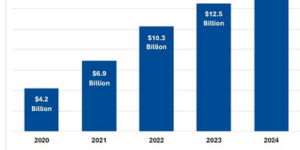Analysts from Standard & Poor’s predicted this week that while personal auto results are starting to stabilize, the continued push for rate in 2024 will set the stage for more faceoffs between regulators and insurers.
Tim Zawacki, principal insurance analyst, S&P Global Market Intelligence, and John Iten, senior analyst and P/C sector lead for S&P Global Ratings, offered a current snapshot of results for all segments of the property/casualty insurance industry—and a forecast for next year during S&P’s webinar, “IN/sights: Outlook and Trends for U.S. Insurers—What to Expect in 2024 and Beyond.” A day later, Allstate’s chief executive also told investors he expects price hikes from his company to continue next year at a different event.
Separating three big states with difficult regulatory environments from the rest of the nation, Allstate’s leader, Tom Wilson, added that failure to get rate increases approved in California, Florida and New York would prompt Allstate to drop existing customers in those three states.
For the most part, Zawacki and Iten repeated information they provided earlier this year about the gap between a profitable commercial lines market and a lagging personal lines segment, while noting that a lower level of inflation is pushing personal auto loss costs down—a trend they are hopeful will continue to improve underwriting results in 2024. (See related articles: Improved Auto Insurance Results Coming—But Not Soon Enough: S&P GMI; Wait ‘Til Next Year: Auto Profit Unlikely to Return in ’23, S&P Says)
But when Moderator Lynn Bachstetter, global head of cross-product market development for S&P GMI, asked directly what they believe will be the biggest impact that P/C insurers will face next year, Zawacki responded, “The interplay between the industry and the regulatory community is going to be interesting.”
“I think we will see results get better. I think we will also continue to see rate increases. And I think the juxtaposition of those two things at some point is likely to generate conflict,” he explained. “Given the politics that tend to be involved in such things, that’s going to become a stickier type of thing for the industry to navigate next year,” he said.

“If we don’t get price increases approved this year in those states, we’re going to move from just not taking on new business to having to say goodbye to some existing customers.”
Tom Wilson, Allstate
Allstate was one of only three companies to be downgraded by the S&P Ratings division this year, according to Iten, who explained that S&P changed its view of the entire P/C sector to negative from stable last October because the distribution of rating outlooks had significantly deteriorated at that point and that all three downgrades were personal lines writers. Unaware of Zawacki’s prognostication, Wilson suggested that the Northbrook, Ill. insurer isn’t willing to continue to tangle with regulators in the three profit-challenged states, speaking at the Goldman Sachs Financial Services Conference yesterday. After Wilson reviewed the levels of rate changes taken in 2022 and 2023, and the favorable impacts on the company’s underlying combined ratios (combined ratios excluding catastrophe losses and prior-year reserve changes), Alex Scott, head of North American Research at Goldman Sachs asked the CEO two direct questions seeking the executive’s views on loss cost severity trend and an understanding of why Allstate’s rate hikes appear to be slowing.
Responding to the severity question with a review of recent history, Wilson noted that auto claim costs went way up after the pandemic—as used car prices soared and the costs to repair cars also went up. In 2023, at the end of the third quarter, “the cost to replace cars has come way down,” Wilson reported, referring to the fact that used car prices have declined, pushing down the market value that insurers have to pay for when they declare crashed vehicles to be total losses.
In fact, Allstate had predicted a severity trend of 11 percent during the first two quarters of the year, but the company now estimates its around 9 percent, he said, noting, however, that repair costs, bodily injury and litigation costs have not declined along with replacement costs.
“We factor that all in, which is why we think we’re going to continue to increase prices next year,” Wilson said.
Scott then noted that Allstate achieved lower levels of price hikes in 2023 vs. 2022, asking the CEO whether the change was the result of the problems in getting approvals in certain states or a strategic slowdown for the carrier. Allstate’s leader suggested that both factors were in play.
Overall, the Allstate brand put through over 27 percent in rate increases since 2022, 16.9 percent in 2022 and 10.4 percent in 2023, Wilson said. Most “regulators understand it. They know we need to raise prices. They can look at our costs and see we’re paying out more than we’re taking in. And so we’ve been able to get pretty good price increases through just about every state except California, New York and New Jersey….
“We feel good about where we’ve gotten there [in the other states]. So, when you see the average price increase come down a little bit, it’s because in many of those places we’ve achieved what we think we need to,” he said, stressing that Allstate is “not all the way there” in its quest to return to profitability as it waits to earn in the higher premium. “It’ll take a while, but you can see it, right? You can see it coming,” he said.
In California and New Jersey, Wilson said Allstate needs 30-plus percent increases in pricing, and about 18 percent in New York.
“If we don’t get price increases approved this year in those states, we’re going to move from just not taking on new business to having to say goodbye to some existing customers,” he said, reiterating remarks he made on the last earnings conference call. “We don’t want to do that. I think the regulators would prefer we not do that. We’re not threatening anybody. We’re just saying we can’t afford to lose that much money in those three states.”
“So, when you look forward next year, either we’ll be successful and we’ll get the kind of rate increases we need to get us back to the margins we want, or we’re going to get smaller in those states. Either way, it should improve auto insurance profitability,” he said.
Back to the 1970s and 80s
A day earlier, during the S&P webinar, Iten led off a discussion of the rating agency’s negative outlook for the P/C insurance sector, noting that in addition to three financial strength rating downgrades for personal lines insurers, S&P has announced rating outlook changes on individual groups—three positive ones on the commercial side and four negative outlook changes, again mainly personal lines writers.
 “The interplay between the industry and the regulatory community is going to be interesting.”
“The interplay between the industry and the regulatory community is going to be interesting.”
Tim Zawacki, S&P Global Market Intelligence
Across the industry, the current distribution of rating outlooks continues to have a negative bias, with negative outlooks on 11 percent of rated P/C insurance entities. The percentage with a stable outlook is 80 percent, which “is right where we were last October when we changed the sector view,” Iten said, adding that S&P’s rationale for its change in sector view also hasn’t moved much. He said one factor prompting the outlook change was the deterioration that S&P saw in capital last year—mainly driven by the rise in interest rates pushing down the value of bond holdings, but also a function of continued business growth. Growth, he said, increased the required capital for the underwriting risk that companies were assuming.
“The situation really hasn’t changed much this year,” he said, noting that interest rates are up, but share repurchases, which were elevated last year, are down now. “And earnings have been fairly strong. So we don’t think there’s been much further [capital] deterioration at least so far this year.”
“The other main factor that hasn’t changed is the deterioration that we’ve seen in personal lines,” he said, noting that beyond the spike in inflation that drove up auto loss costs, elevated cat losses were significant factor in the deterioration of personal lines writers last year and continued into 2023.
Zawacki commented on personal insurer top lines. “You’re seeing incredible growth in home and auto premiums driven by economic inflation, largely just in terms of the costs to repair and replace vehicles, the replacement costs for homes going up, as well as the risk around insuring both residential and commercial property going up, and in turn reinsurance prices increasing.”
Putting some numbers to what he termed “outsized expansion in premium growth,” the S&P GMI analyst said that homeowners insurance premiums across the industry rose 13 percent in the third quarter. “And then for the auto lines, you’re looking at mid-teens expansion, which is something that we haven’t seen in the scope of our data. You really have to go back to the mid-80s, or even potentially the mid to late 1970s when inflation was really rearing its ugly head on loss costs to see that sort of expansion,” he reported, noting that the industry is still playing catch-up with loss cost trends.
“It all adds up to another underwriting loss for the P/C industry in the third quarter,” he said, reporting that S&P’s estimate of an underwriting loss in excess of $7 billion is a surprise to professionals writing only commercial lines business. “It’s just not the world they’re living in—a time when combined ratios are above 100. Their results are very strong,” he said.
Iten noted that while by-line statutory results are not available for 2023, in 2022, the personal lines sector combined ratio deteriorated by 8 points to 110. Referencing GAAP results for S&P-rated companies that report quarterly, Iten said underlying loss ratios for carriers writing predominantly personal lines improved slightly this year—”anywhere from one to three points for most.”
Underlying loss ratios, however, exclude the impacts of catastrophe losses, which have more than offset the few points of improvement. “At the end of the day, combined ratios were still higher for the first nine months versus what we saw in the prior year. But the improvement in the underlying loss ratio does suggest that maybe—puts out the hope anyway that the [strong] rate increases,….along with the other underwriting actions like cutting back in certain areas, are starting to have some impact.”
At the Goldman Sachs conference, Wilson shared presentation slides showing that the Allstate brand implemented over 27 percent of rate increases since 2022, including 10.4 percent through October of this year, and its National General brand increased rates about 10 percent in both years. “We’ll continue to pursue rate increases to restore auto insurance margins back to target levels,” he said.
Another presentation slide showed Allstate’s personal auto underlying combined ratio dropping to 98.8 in third-quarter 2023, from 104.4 in third-quarter 2022. Allstate’s third-quarter financial statements reveal that the personal auto reported combined ratio remained above breakeven at 102.1, but fell more than 15 points from a third-quarter 2022 figure of 117.4 in third-quarter 2022—largely prior-year reserve development.
Through nine months, Allstate’s underlying combined ratio was essentially unchanged from last year, 101.2 in 2023 vs. 101.7 in 2022, while the reported combined ratio improved to 104.9, down from 109.3 in 2022.
According to Wilson’s presentation slides, and his remarks throughout the session, there’s a vast difference in the underlying combined ratios for the three problem states compared with the other 47. His slides included a graphic illustrating that 59 percent of the 2023 auto book is now producing combined ratios of 100 or better, compared with just 29 percent in 2022. For California, New York and New Jersey together, Allstate’s underlying auto combined ratio for the first nine months of 2023 was 119.6. It was 97.2 for the rest of the states and D.C., a heading on the chart revealed.
Wilson also addressed the three states separately during a discussion of distribution channels. Focusing on the Allstate exclusive agent channel, he said that productivity (year-to-date new applications per agent) declined 5 percent in total. But excluding the “three profit-challenged states,” where Allstate has already severely restricted new business, productivity actually rose 13.4 percent. “We’re down over 75 percent in new business in those [three] states,” Wilson said.
Personal Lines Property
As for homeowners, in spite of the fact that catastrophe losses added 29 points to the third-quarter homeowners combined ratio (104.4), Wilson remains bullish about the line as he pointed out that Allstate’s “generated industry-leading underwriting margins outperforming the industry by 12 points from 2013 to 2022.”
Scott asked Wilson specifically about homeowners business in the state of Florida, questioning the CEO about whether last year’s legislative reforms in the state are producing any favorable impact on loss costs. “The legislative changes were primarily around some litigation stuff, which is a good idea. [But] it’s not going to fix Florida. And we never thought it. We thought it was a good thing to do. We’re going to keep getting smaller in Florida until such time as you can get an adequate return. And so we’re a fraction of what we used to be. Our market share used to be 12 percent. Maybe we’re less than 3 [percent] today, and we’ll get smaller,” he said.
During the S&P webinar, Bachstetter also asked Zawacki to talk about the property insurance situation in Florida and California, noting that many attendees sent in multiple questions about those two states. Zawacki went on to predict that “the idea of socialization of risk,” or property backstops would reemerge in 2024—but not necessarily because of hurricanes in Florida or wildfires in California.
Such ideas “surfaced after Katrina, Rita and Wilma back in 2005 on the heels of a very active 2004 hurricane season. And ultimately is was put on the back burner for a dozen or so years until Irma, Harvey and Maria in 2017,” he said, noting that each time—and even in the case of California wildfires, “these were isolated occurrences that impacted only small segments of the population.”
“What we’re seeing in recent years is that the severity and the impact on the industry of convective storms, which are not as bound by geography as hurricane and wildfire, has perhaps changed the thinking [about] states like Iowa, South Dakota, Wisconsin,” where insurers are experienced “some really high loss ratios in the property insurance business.”
“So, you’re seeing reinsurers become more reluctant or not at all willing to write business for companies that are heavily concentrated in the upper Midwest,” he said. “As this impact of climate spreads, I think the push to some sort of solution, whether in the form of a backstop or otherwise, will be something that gets discussed again just given the extent of the population that gets impacted by either unaffordable insurance premiums or unavailable insurance premiums.”
“We’re seeing in Wisconsin, in particular, the town mutual model that’s existed for 150 years really get washed under in this fallout from the reinsurance market just not having the appetite to be so geographically concentrated among cedents that may have small balance sheets.”
“That’s something worth watching” if the frequency and severity of catastrophes of recent years continues, he said.
Related article: On Tolstoy and Insurance Troubles in the Heartland (insurancejournal.com)





















 Lemonade: 700K Customers on the Car Waitlist
Lemonade: 700K Customers on the Car Waitlist  Severe Midwest Storms Result in Baseball Size Hail
Severe Midwest Storms Result in Baseball Size Hail  The Future of the Insurance Customer Experience Is Unity, Personalization
The Future of the Insurance Customer Experience Is Unity, Personalization  Insurers Need End-to-End Strategy to See Double the ROI in AI Implementation
Insurers Need End-to-End Strategy to See Double the ROI in AI Implementation 








